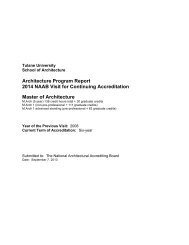Architecture Program Report Tulane University New Orleans ...
Architecture Program Report Tulane University New Orleans ...
Architecture Program Report Tulane University New Orleans ...
Create successful ePaper yourself
Turn your PDF publications into a flip-book with our unique Google optimized e-Paper software.
have a close mentoring relationship with an instructor in order to achieve the required<br />
task-based synthesis of knowledge. Architectural programs are thus based on low<br />
student to teacher ratios, and are consequently labor intensive.<br />
Fourth, the comprehensive integration of digital technologies throughout the design<br />
process (and for faculty, staff and students alike) and in professional practice is requiring<br />
a significant investment on the part of schools. This investment in educational equipment<br />
and the necessary infrastructure to support new digital and materials technologies was<br />
not previously required of the schools, and as such represents an exceptional economic<br />
challenge.<br />
Finally, fundraising is a historically difficult task for schools of architecture. This based<br />
not only on lower architect compensation levels, but on a lack of tradition for alumni<br />
giving and the support of other interested individuals.<br />
b. Competitive Educational Environments<br />
The <strong>Tulane</strong> School of <strong>Architecture</strong> competes on several levels for students, faculty and<br />
recognition. The first of these, though perhaps not the most significant, exists at the state<br />
level. There are currently five accredited architecture programs within the State of<br />
Louisiana, including <strong>Tulane</strong>. However, <strong>Tulane</strong> has the major distinction of being the only<br />
private university in the mix, with both positive and negative results. On the one hand,<br />
students and faculty are drawn to the reputation of <strong>Tulane</strong> in general, viewing it as a<br />
university of distinction in the State of Louisiana. On the other hand, economic forces—<br />
public and market forces in particular—sometimes dictate that funding for the <strong>Tulane</strong><br />
School of <strong>Architecture</strong> is of a lesser priority than state-affiliated schools.<br />
The second 'competitive environment' is regional in nature, and is an arena in which the<br />
School of <strong>Architecture</strong> competes admirably for students and faculty alike (the regional<br />
group of schools includes only two schools designated as "peer institutions").<br />
Third, the School of <strong>Architecture</strong> competes nationally for excellent students and faculty.<br />
Because of the status of <strong>Tulane</strong> <strong>University</strong>, the reputation of the School—and its prime<br />
location in <strong>New</strong> <strong>Orleans</strong>—the School of <strong>Architecture</strong> is able to attract students and<br />
faculty of the highest quality (as noted below in the SWOT analysis). Principally from the<br />
Northeast and Northwest, students represent almost all the fifty states and several<br />
foreign countries.<br />
Lastly, the School of <strong>Architecture</strong> has competed historically on the international stage for<br />
students with excellent profiles. Lately, these numbers have fallen short of ideal due to a<br />
rather inactive post-professional program (which is being remedied, as outlined below),<br />
as well as the higher profile of international programs for the study of architecture.<br />
Nonetheless, there is an historic 'draw' of students from Latin America and the<br />
Caribbean regions, which adds to the diversity and reputation of the program. <strong>New</strong><br />
agreements with schools such as the Brandenburg Technical <strong>University</strong> (BTU) in<br />
Cottbus, Germany—a semester-long exchange program—and the School of<br />
<strong>Architecture</strong>'s agreement with the Vienna Technical <strong>University</strong> (Technische Hochschule<br />
Wien) have also upgraded the visibility of the program on an international stage.<br />
Additional programs based on international agreements are in the offing as well.<br />
While the <strong>Tulane</strong> School of <strong>Architecture</strong> is, at least in part, competitive with the nation's<br />
architectural programs of excellence, it is only weakly so. The current strategic planning<br />
initiative reflects new programs of development and educational opportunities for the<br />
School of <strong>Architecture</strong> that will further the program in its pursuit of excellence at the














